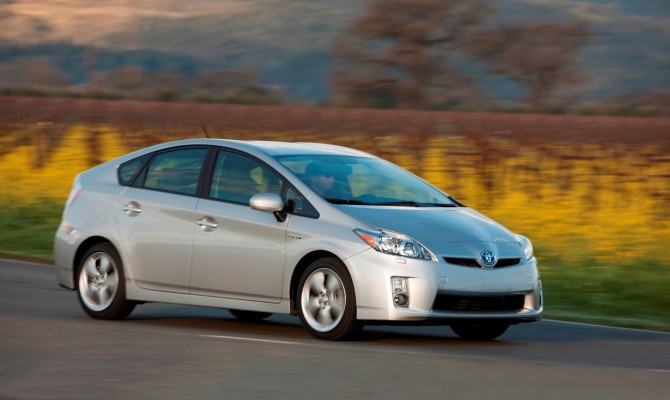“Finding that ‘perfect for you’ used Prius up can be a challenge… but well worth the effort.”
Toyota’s Prius is the most successful hybrid-powered vehicle ever produced and it already had more than a million owners worldwide when a reworked third generation Prius was introduced for the 2010 model year.
In addition to even better fuel economy and performance, this Prius is also quieter and a little roomier inside. It can run longer distances in its pure electrical power mode and its four driving modes allow a driver choose a desired level of motive power and fuel-efficiency.
The gas engine is a larger 1.8-litre capacity Atkinson-cycle four-cylinder that provides more torque and has an exhaust heat recirculation system to reduce heat waste. Warming the engine faster has the added benefit of heating a cold passenger cabin a little quicker. It’s also the first belt-less (less maintenance!) Toyota engine.
On the electric side of the hybrid drive system, the inverter, motor and transaxle shrunk in size making it 20 per cent lighter than the previous system. The 2010 Prius also came with an enhanced regenerative braking system that feeds more electrical charge back to the battery.
The official city driven fuel rating for the 2010 Prius was 3.7 L/100km and 4.0 L/100km on the highway and it was the most fuel-efficient car sold in Canada. Using the revised (2015) fuel consumption rating method it’s rated at 4.7 L/100km in the city and 4.9 L/100km on the highway. That converts to a still outstanding 58 mpg, in pre-metric (imperial gallon) figures.
While it may not look too much different, the front roof pillars of this third generation Prius are further forward and the roof’s highpoint moved towards the rear. Although small, these changes allowed more rear passenger headroom and improved the car’s aerodynamics.
Interesting new options also included a moon roof with solar panels that powered a smart air conditioning system that keeps Prius cool while parked. Intelligent Parking Assist can automatically perform a precision parallel park. And my favourite, Dynamic Radar Cruise Control. In addition to speed, you can also set it to maintain a safe distance from the vehicle immediately ahead.
Standard safety features include seven airbags, the seventh being an additional knee airbag for the driver. The front seats also come with “Active” head restraints, which reduce whiplash in a collision.
A smaller (short wheelbase) version, called the Prius C, and a (long wheelbase) wagon version, called the Prius V, were both introduced for the 2012 model year. Regular Prius also underwent a modest front facelift (restyled headlights, grille and front bumper) and got new rear lighting. The 2013 model year brought a plug-in version called the Prius PHV. A larger hybrid battery pack allows Prius PHV to be driven about 20 km in its pure electric mode.
Hybrid battery pack failure is a concern for many used Prius buyers. However, the nickel-metal hydride battery in a Prius has proven to be extremely durable. A replacement is covered under an 8-year/160,000km Toyota warranty and it can last well in excess of ten years.
High resale values reflect the high level of consumer confidence that used buyers have in the Toyota Prius. Finding that ‘perfect for you’ used Prius up can be a challenge… but well worth the effort.
**********
Price Check: 2010 – 2013 Toyota Prius (September 2014)
Year Edition Expect to Pay Today
2010 4-door hatchback $16,000 to $19,000
2011 4-door hatchback $18,000 to $22,000
2012 4-door hatchback $20,000 to $24,000
2013 4-door hatchback $23,000 to $27,000
Prices vary depending on a used vehicle’s condition, mileage, usage and history. A complete mechanical check should always be performed by a reliable auto technician prior to purchase.
**********
Safety Recalls: 2010 to 2013 Toyota Prius:
2010: An inconsistent brake feeling may be perceived after ABS actuation during slow and steady application of the brakes on rough or slick road surfaces. Stopping distances may be increased compared to expectation for a given pedal force. Dealers will rewrite the programming of the ABS control Unit.
2010: A fatigue crack could develop in the brake pressure accumulator. If this occurs, nitrogen gas could leak into the brake fluid and gradually cause the brake pedal stroke to become longer, resulting in decreased hydraulic pressure. Dealers will inspect the brake booster pump and, if necessary, replace it with an improved unit.
2010 to 2014: The Intelligent Power Module (IPM), which is part of the hybrid system inverter assembly, could become damaged under certain driving conditions. This could cause various instrument panel warning lights to illuminate and cause a reduction or loss of motive power. Dealers will update motor/generator and hybrid control ECU software and affect repairs as necessary.
Recent Comments
- { Enjoyed your Forest of Bowland in the BMW X5M, particularly the photo of the BMW in front of the main part of Stonyhurst College where... }
- { Bantam designed the Jeep, not Willy's or Ford. The American military gave the original Bantam prototype to Willys and Ford to copy. There is plenty... }
- { All Escalades come with a 6.2-lilter V8 engine that produces 420 horsepower. A six-speed automatic is the only transmission offered and drives the rear wheels.... }
- { Alexandra is an excellent journalist. }
Popular Posts
- Journey to a ‘Sparkling’ Luxury Okanagan Resort “Four lucky readers will put a Dodge Journey’s weekend-...
- The Need For Speed: Hike Those Highway Limits More than half of those polled believe the province sho...
- Drives-U-Crazy… Erratic drivers. An early morning drive from Kelowna to Vancouver is nor...
- Readers Respond: The Pros and Cons of Increasing B.C. Speed Limits Increasing the speed limits will only increase risk to...
- Honda CR-V Review: The Compact Crossover To Get Things Done The CRV is a very stylish and aerodynamic crossover veh...







